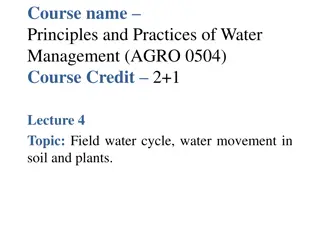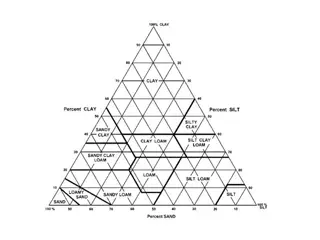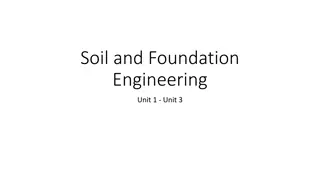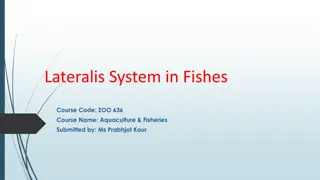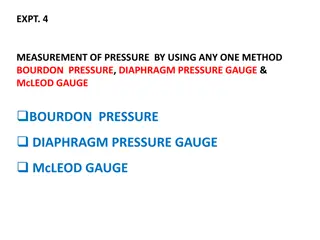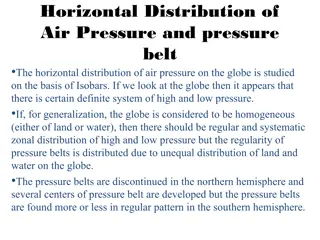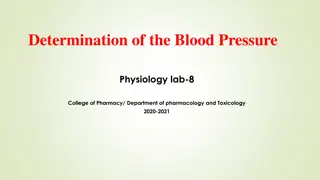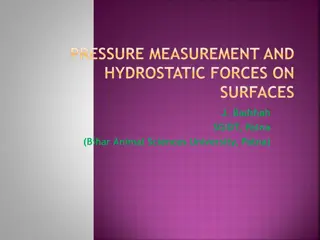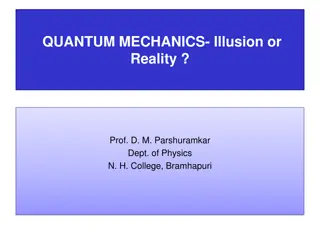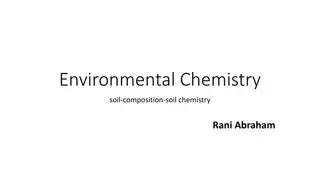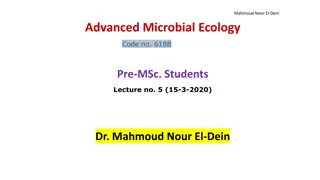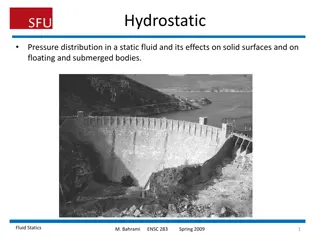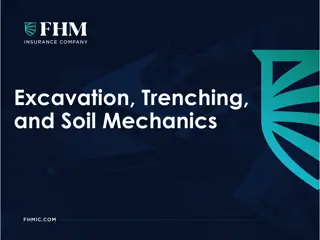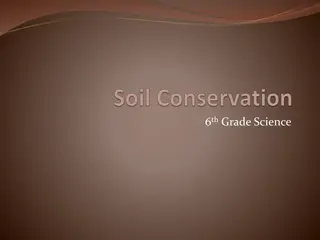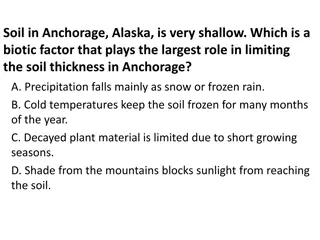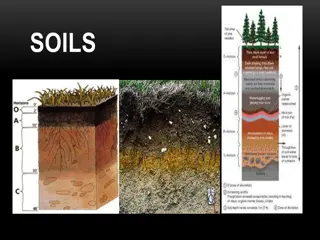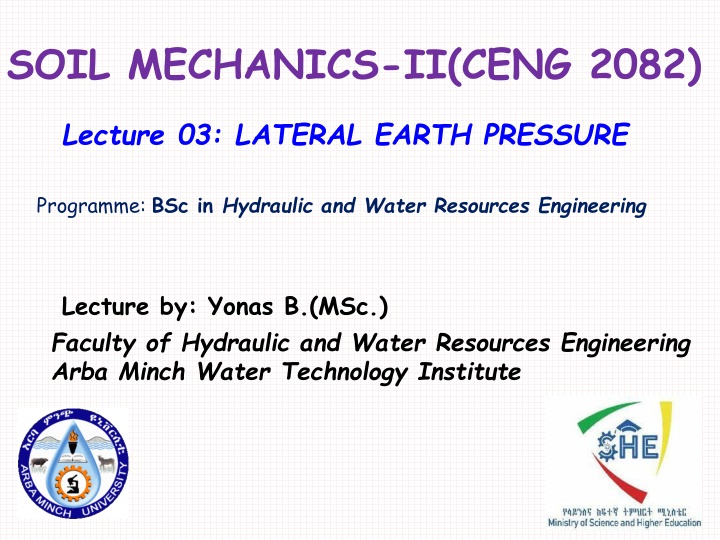
Lateral Earth Pressure in Soil Mechanics
In this lecture, we delve into lateral earth pressure in soil mechanics, focusing on retaining walls and structures. The concepts of active, passive, and at-rest lateral earth pressure are explored, along with theories by Rankine and Coulomb. The importance of understanding soil parameters in determining lateral earth pressure is emphasized, along with factors influencing its magnitude. Backfill soil behind retaining structures plays a crucial role in developing lateral earth pressure. Engineering students studying hydraulic and water resources will gain valuable insights from this lecture.
Download Presentation

Please find below an Image/Link to download the presentation.
The content on the website is provided AS IS for your information and personal use only. It may not be sold, licensed, or shared on other websites without obtaining consent from the author. If you encounter any issues during the download, it is possible that the publisher has removed the file from their server.
You are allowed to download the files provided on this website for personal or commercial use, subject to the condition that they are used lawfully. All files are the property of their respective owners.
The content on the website is provided AS IS for your information and personal use only. It may not be sold, licensed, or shared on other websites without obtaining consent from the author.
E N D
Presentation Transcript
SOIL MECHANICS-II(CENG 2082) Lecture 03: LATERAL EARTH PRESSURE Programme: BSc in Hydraulic and Water Resources Engineering Lecture by: Yonas B.(MSc.) Faculty of Hydraulic and Water Resources Engineering Arba Minch Water Technology Institute
Objectives Understand lateral earth pressure. Determine lateral earth pressure. By Defau K.(Msc) 2
CHAPTER OUTLINES 3.1 Introduction 3.2 Definitions 3.3 Lateral Earth Pressure( At Rest, Active And Passive) 3.4 Rankine s Lateral Earth Pressure theory 3.5 Coulomb s Lateral Earth Pressure theory 3
3.1 Introduction Vertical slopes of soil are supported by retaining walls, cantilever sheet pile walls,sheet pile bulkheads, bracedcuts, and other, similar structures. Lateral earth pressure is lateral stress from soil laterally on soil retaining structures. Retaining structures may be classified as : Retaining walls Sheet-pile walls Sheet-pile bulkheads Braced cuts The proper design of these structures requires estimation of lateral earth pressure (LEP). 4
3.1 Introduction Lateral Earth Pressure ?? (R.P. Weber) ?? (R.P. Weber) 5
3.1 Introduction A retaining wall is a structure that is used to support a vertical or near vertical slopes of soil. The resulting horizontal stress from the soil on the wall is called lateral earth pressure. To determine the magnitude of the lateral earth pressure, a geotechnical engineer must know the basic soil parameters that is, unit weight , angle of friction , and cohesion c for the soil retained behind the wall. In the evaluation of the magnitude of this lateral earth pressure, it is assumed that the soil behind the wall (called backfill soil) is on the verge of failure and obeys some failure criterion, for example, the Mohr-Coulomb failure criterion. 6
3.1 Introduction LEP is a function of several factors, including the following: The type & amount of wall movement Type of backfill used The effective unit weight of the backfill soil, Ground water position The drainage condition in the backfill Ground Surcharge Surcharge application 7
3.2 Definitions Backfill:is soil at back of retaining structures, which can develop LEP. This soil in practically, granular, but sometimes may be C-pa soil. At rest earth pressure coefficient (k0) is the ratio between the lateral and vertical principal effective stresses when an earth retaining structure is at rest (or is not allowed to move at all). Active earth pressure coefficient (ka) is the ratio between the lateral and vertical principal effective stresses when an earth retaining structure moves away from the retained soil. Passive earth pressure coefficient (kp) is the ratio between the lateral and vertical principal effective stresses when an earth retaining structure is forced to move against a soil mass. 8
3.3 Lateral Eath Pressure( At Rest, Active And Passive) Three Types of LEP i. PRESSURE AT REST-If the wall restrained/Fixed from moving the LEP at any depth is referred to as earth pressure at-rest ii. ACTIVE EARTH PRESSURE-If the wall tilts away from the retained soil Active earth pressure. iii. PASSIVE EARTH PRESSURE- If the wall is pushed into the retained soil Passive earth pressure. 9
Type of lateral Earth pressure developed on retaining walls :(a)at rest,(b)active&(c)passive 10
I. At Rest Earth Pressure If the wall is rigid and does not move with the pressure exerted on the wall, the soil behind the wall will be in a state of elastic equilibrium. Consider a prismatic element E in the backfill at depth z shown in Fig. = = constant = h h z K 0 v ?? =? ? ???? ? Where: Ko is the at rest earth pressure coefficient 11
I. LEP at-rest If the wall is at rest and is not allowed to move at all, either from the soil mass or into the soil mass (i.e., there is zero horizontal strain), the lateral pressure at a depth Z is: K = ' But for soils; Without GWT h o o If GWT is there = + ' K u h o o But for C- soils; ho = Ko H 2 c (Ko)1/2 Where u = pore water pressure Ko = Coefficient of at-rest earth pressure 12
LEP at-rest . Jacky eqn-For coarse material/NC soils ' 1 sin K o ( 1 ) For overconsolidated = OCR ' sin ' sin Ko The total force Po, per unit length of the wall can be calculated from the pressure diagram as: Based on experiments, the typical value of K0 is about 0.40 0.50 for sand, 0.35 0.70 for normally consolidated clay, and 0.50 3.00 for over- consolidated soil. Where is the effective angle of internal friction of the soil. another formula is proposed by Brooker and Ireland (1965) for normally consolidated clay: = 0.95 sin ' K 0 13
CONT Empirical correlation between the coefficient of lateral earth pressure K0 and the plasticity of normally consolidated clay is proposed by Alpan (1967) 0 0.19 K = + 0.233log( ) PI Where PI is the plasticity index of the soil. other empirical correlations were proposed by Mayne and Kulhawy (1982) = + 0.4 0.007( ) for 0 < PI < 40 K PI 0 = + 0.64 0.001( ) for 40 < PI < 80 K PI 0 14
3.3. Active and Passive Lateral Earth Pressures Failure of the backfill soil occurs by two mechanisms depending on the direction of wall displacement. If the displacement of the wall is away from the backfill soil the resulting failure is called active and the lateral pressure exerted on the wall by the backfill soil is called active lateral earth pressure. A passive failure occurs if the wall is displaced towards the backfill soil until the limiting displacement is achieved. the passive resistance provided by the backfill soil against the wall displacement is called passive earth pressure. In the next sections, we will deal with two active and passive earth pressure theories: one proposed by Rankine (1857) and the other by Coulomb (1776). 15
3.3.1 Rankines Active and passive Theory Consider a vertical frictionless (smooth) wall retaining a soil mass in both front and back of the wall; vertical walls only ??= ????for non-cohesive soil = 2 / c zK K For cohesive backfill a a a For lateral earth pressure (active) : 16
RANKINE ACTIVE EARTH PRESSURE 3 = 1 . tan2 (45- /2)-2c.tan (45- /2) a = v . tan2 (45- /2)-2c.tan (45- /2) From chapter 1; Mohr- coulomb theory a = v . Ka 2c Ka Ka = tan2 (45 - /2) for C- soils Tension zone 1 sin 1 sin + = where K a 17
ACTIVE EARTH PRESSURE Note : The tensile stress decreases with depth and becomes zero at a depth z = zc or zcKa 2c Ka = 0 and c z z = 0 v = 0 ; a = -2c Ka z = H v = H 2 = zc = depth of tensile crack c K a For undrained condition 18
coefficient of active earth pressure, Ka sin 1 + 1 sin = K i) a *** for horizontal backfill while (iii) use for sloping backfill. Normally (i) and (ii) use = tan2 o 45 K ii) a 2 2 2 cos cos cos iii) = cos K a + 2 2 cos cos cos Lateral soil pressure, a = Ka H for non-cohesive Resultant force per unit length of wall, Pa = Ka H2 for non-cohesive 25
EXAMPLE ACTIVE LEP Calculate the Rankine active force per unit length of the wall shown below, and also determine the location of the resultant. =15.7kN/m3 =30 5m c =0 Ans : Pa = 65.4kN/m , y = 1.67m 26
3.3.2 RANKINS PASSIVE CONDITION For total passive pressure for non cohesive soils: ??= ????for non-cohesive soil 1 = 2 2 P K H p p For total passive pressure for cohesive soils/C- 1 ' ' soils : sin + + sin ' 1 ' = + 2 ' c p z 1 sin ' 1 sin ' = + ' 2 ' k c k z p p + 1 sin ' ' = = + 2 tan ( 45 ) k p 1 sin 1 ' 2 = k Ka < K0< Kp p k a 27
3.3.2 RANKINS PASSIVE CONDITION WITH COHESIVE BACKFILL For lateral earth pressure (passive) : = + 2 zK c K p p p 28
coefficient of passive earth pressure, Kp i) sin 1 + 1 sin = K *** horizontal backfill while (iii) use for sloping backfill. Normally (i) and (ii) use for p ii) = + tan2 o 45 K p 2 iii) + 2 2 cos cos cos = cos K p 2 2 cos cos cos 29
EXAMPLE PASSIVE LEP For the retaining wall considered below, what is the Rankine passive force per unit length of the wall? =15.7kN/m3 =30 5m c =0 Ans : Pp = 588.75kN/m , y = 1.67m 30
Active Earth Pressure- Backfill Soil Submerged If backfill is affected by GWT, its effect is considered during determination of LEP 1H = 2 Pw 2 = H w 31
Example Forces( area of LEP diagram) Location of resultant active force
Example 2(Layered soils) From the following retaining wall having backfill soil profile, determine lateral earth pressure and force with its point of 1 sin action. = K a + 1 sin 1=17kN/m3 c1=0 1=34o 2=19kN/m3 c2=10kPa 2=16o A Ka1=0.283 calculated h1=2m B h=5m h2=3m Ka2=0.57 calculated C
Solution: Horizontal stresses at each points as follows: A h1=2m ??= ?? ?? ? 10.4kPa 4.2kPa B ???= ?? ?? ? = ? h=5m h2=3m ???= ?.??? ?? ? = ??.? KN/m2 Ka1=0.306 Is just above point B. C 36.6kPa Ka2=0.283 ???= ??? ?? ? ??? ???= ?.?? ?? ? ? ?? ?.?? = ?.?? KN/m2 Is just Below point B. ???= ??? (?? ??+ ?? ??) ??? ??? = ?.?? (?? ? + ?? ?) ? ?? = ??.?? KN/m2 Total horizontal force: ?.?? = + + 10 4 . 2 / 2 2 . 4 ( 36 77 . ) 3 / 2 71 6 . / Pa kN m
WORK EXAMPLE 4 Determine the active force per unit length of the wall for Rankine state. Also find the location of the resultant. = 16 kN/m3 = 30 3m c = 0 GWT sat = 18 kN/m3 = 30 c = 0 3m z Ans : Pa = 128.394kN/m , y = 1.78m
Lateral Earth Pressure due to Surcharge For soils; = + ' ' k z k q p p p s = + ' ' k z k q a a a s = p ' + 2 P k H k q H 1 p p s 2 = a ' + 2 P k H k q H 1 a a s 2 36
Active Earth Pressure-Backfill Soil Partly Submerged & Uniformly Surcharge Load
For C- soils; = + ' ' 2 ' k z k q c k a a a s a = + 2 ' 2 ' P k H k q H c H k 1 a a a s a 2 = + + ' ' 2 ' k z k q c k p p p s p = + + 2 ' 2 ' P k H k q H c k 1 p p p s p 2 39
Active Earth Pressure-Backfill Soil Partly Submerged & Uniformly Surcharge Load 40
WORK EXAMPLE 5 A frictionless retaining wall is shown below, find the passive resistance (Pp) on the backfill, and the location of the resultant passive force. q=10kN/m2 =15kN/m3 =26 4m c =8kN/m2 Ans : Pp = 512kN/m , y = 1.0m
SLOPING SURFACE-ACTIVE EARTH PRESSURE 1 2 2 ' cos cos cos = 2 2 P K H a a = cos a k + 2 2 ' cos cos cos
SLOPING SURFACE-PASSIVE EARTH PRESSURE 1 = 2 2 P K H p p
3.3.2 Coulombs Earth Pressure Theory As described in the previous sections, the Rankine earth pressure theory: (1) assumes the retaining wall is frictionless (or smooth), and (2) considers stress states and uses such tools as the Mohr s circle of stress. Coulomb (1776) proposed a theory to determine the lateral earth pressure on a retaining wall by assuming a granular backfill (c = 0) and a plane sliding surface. He account for the effects of friction (usually expressed by angle ) between the backfill and the wall. Besides, he considered the more general case of the sloped face of a retaining wall, and in this respect, Coulomb s theory is a more general approach than the Rankine theory described earlier. 48
COULOMB'S EARTH PRESSURE THEORY Coulomb made the following assumptions in the development of his theory: 1. The soil is isotropic and homogeneous 2. The rupture surface is a plane surface 3. The failure wedge is a rigid body 4. The pressure surface is a plane surface 5. There is wall friction on the pressure surface 6. Failure is two-dimensional and 7. The soil is cohesionless 49
Cont Figure 3.8: Direction of active and passive forces when wall friction is present. 50

